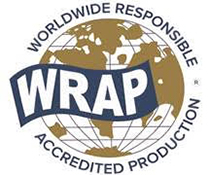New WRAP Policies:
Updated June 2020
Worldwide Responsible Accredited Production (WRAP) 12 Principles
2. Prohibition of Forced Labor
Facilities will not use involuntary, forced, or trafficked labor.
Facilities will maintain employment strictly on a voluntary basis. Facilities will not use any forced, prison, indentured, bonded or trafficked labor. This will include ensuring that any workers they hire will be under labor contracts that fully comply with all relevant legal requirements and do not impose any form of coercion (including imposing substantial fines or loss of residency papers by workers leaving employment or restricting a worker’s ability to voluntarily end his/her employment). In addition, workers should not be employed subject to any financial or collateral guarantee or debt security; any recruitment fees involved should be borne by facilities, not workers. Further, facilities will ensure that the workers’ passports travel documents are not withheld, and that all written contracts are in a language understood by the workers.
From August 1st of 2017 WRAP has been requiring that all facilities retain at least 30 days of CCTV records, though it recommends up to 90 days as a best practice.
CCTV records must be kept for 30 consecutive days and must include:
- 24/7 coverage
- All production and non-production hours
- Nights, weekends and holidays
WRAP changing approach to encourage transparency on working hours
Beginning on January 1, 2016, WRAP has changed its certification criteria so as to allow factories that meet certain conditions to qualify for accreditation, even if they are not yet in full compliance with the limits on working hours set in local laws. Those conditions are:
- Being fully transparent about their working hours;
- Ensuring that those hours are all being worked voluntarily, in conditions that protect worker safety and health;
- Compensating all employees fully in accordance with WRAP's Principle on Compensation and Benefits; and
- 4. Showing progress, from one audit to the next, toward meeting the working hour requirements set in local laws.
That final element, the demonstration of progress described in Point 4 above, will involve putting into place a Working Hours Action Plan, wherein factory management will establish reduction targets to be achieved over the course of the facility's certification cycle. The goal is to facilitate actual progress by identifying root causes of excessive working hours and addressing those directly, rather than merely masking the problems through the use of double books. WRAP envisions this as being a very factory‐specific process, and intends to work with each facility on a case‐by‐case basis. |






